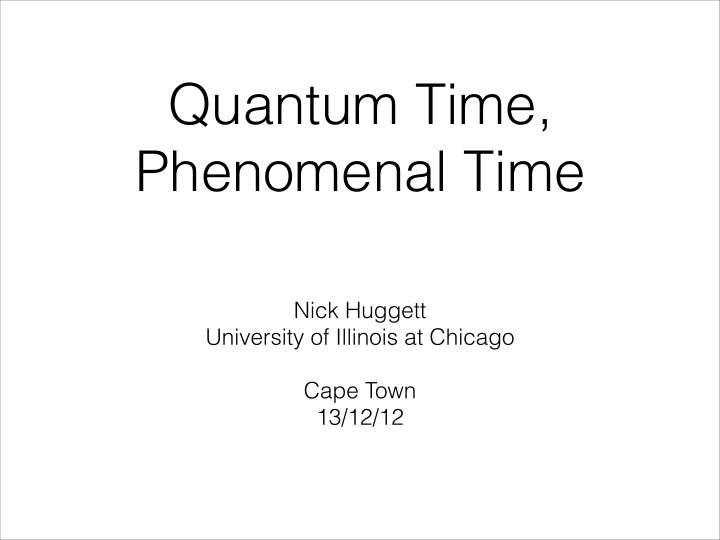



Quantum Time, Phenomenal Time Nick Huggett University of Illinois at Chicago Cape Town 13/12/12
Classical Models of Time • Minimal Model: Time is well-represented by the differential structure of R . + metric; x space; oriented? Just elaborations of the minimal model into various classical models. • Program: show that temporal phenomena – physical, conceptual, psychological, etc – are well-represented. E.g., change is represented by different states at different points. • 'Passage': is passage not well-represented in our current physics? Is this a clue to quantum gravity? To say the least, some unexplained phenomenon would be useful!
• Courant and Robbins on the limit of a function: "The independent variable does not move, it does not 'tend to' or 'approach' a limit a in any physical sense … No part of [the (e, ∆ ) definition], e.g. ' x → a' has a meaning by itself." " Time does not move, it does not 'tend to' or 'approach' the present in any physical sense … No part of [the (e, ∆ ) definition], e.g. ' t → present ' has a meaning by itself." "... leaves out something real to the intuition [a '"dynamic" notion of approach', but is] an adequate mathematical framework for expressing our knowledge of these concepts." • Familiar but pointed: a problem representing passage mathematically, not just in this or that physical theory. Taking advantage of this insight requires new physics and mathematics .
• Maudlin: a temporal orientation represents passage. It doesn't offer an analysis but we don't need one of our experience… "We can have the lingering feeling that mathematical objects per se are not fit to represent the passage of time ... but the apparent inadequacy must be an illusion... everyone is perfectly familiar with the passage of time" – but again, to represent the physical nature of passage in a theory, we want more than an orientation. • McTaggart: add an absolute past-present-future division to the classical model… – but is only one point present, or all? Either way, it fails to represent passage.
• Now, I think that the broadly empirical criteria for 'passage' that I understand – felt difference from spatial separation, or causes preceding effects, or change, etc – are (probably) well- represented within the classical model. • What about Maudlin's feeling of passage, something beyond the criteria I understand? Suppose it's a failing on my part… – our minds would be the only thing we know of sensitive to this feature of quantum gravity, not anything material, even brains. • But maybe I'm wrong – in that spirit, reflecting on the lesson from McTaggart and Maudlin that adding structure to the classical model does not work if we want physics to explain passage… – what if time were represented by a weaker structure? – passage? I don't know. My project is actually 'empirical analysis' of theoretical concepts: e.g., time in quantum gravity.
• Ways to weaken classical models: Non-Lorentzian metric Conformal spacetime symmetry Non-metrical manifold Non-differentiable manifold Non-Commutative manifold • What happens to time – relative to the classical models? (To passage?)
Non-Lorentzian Spacetime • Newtonian structure? Leaves the minimal classical model. • Non-commutative spatial geometry, xy ≠ yx … y x • Algebraic commutative geometry – the algebra of fields polynomial in the coordinates: (Roughly) [x,y]=0 characterizes planar differential geometry. ‘Einstein algebras’ characterize models of GTR (Geroch). • Non-Commutative – R d θ : [x,y] = θ polynomials – invariant area. Represent R d θ in the plane with * -multiplication: x * y - y * x = θ Replace all products in the action: ∫ dt L –> ∫ dt L *. But time commutes and is treated classically.
Conformal Symmetry • Witten: "… one does not have spacetime any more, except to the extent that one can extract it from a 2-dimensional field theory." • σ α ( α =0,1) are worldsheet 'time' and 'space' coordinates, X( σ ) background spacetime coordinates – a 2-D vector field! • h is the 'auxiliary metric' for σ α , • -product is the background metric – inner product on the X-field, so not spatiotemporal? • h adds no physical significance, so theory has conformal symmetry wrt to it – string 'time' is scale invariant. • But more than an interesting repackaging of old goods?
Non-differentiable & Non-metrical Manifold • Causal Set Theory – leave to the experts! Except to mention attempts by Reichenbach, Grünbaum and van Fraassen to provide a causal theory of relativity – to quotient over the supposed empirical metrical indeterminacy of spacetime. (Here I like the idea that node cardinality might eliminate metrical amorphousness!)
Non-Commutative Spacetime • [x,t] = θ , proceed as with non-commutative space… – backwards causation (Seiberg et al) – non-unitary evolution (Gomis & Mehan) … time changed enough to break QM. • String theory space-time non-commutation (Yoneya), and yet unitary (Seiberg et al) – how to reconcile?
Recommend
More recommend